
| Report on Fishing Boats Village of Kruengraya Port of Malahayati Eddie Bloom Vice President Communication AIRO Submitted February 7, 2005 Background Sunday morning I met with Dr. Alwi Shihab, Minister of Peoples Affairs, at Pondolopo and expressed our need to identify the local fishing village Sea Commanders (referred to as the "Paglima Laut") and the remaining hierarchical decision making structure for any given area. The Minister was very helpful and immediately called one of his Deputy Army Commanders, General Dadeng Wirasuta, to take me back to the fishing village of Kruengraya. We went in a military transport with two additional military personnel. They called ahead to notify the local command post in Kruengraya that we were coming and had several local authorities there waiting by the time we arrived about an hours drive later. According to the records still in tact there, I was able to review them myself, there were 12,289 people registered as residing in Kruengraya before December 26, 2004. Currently, their population is at 10,150. They have to date confirmed 1,026 dead (bodies recovered) and still have 1,113 missing. They do presume most of the missing to also be dead, but some may have immediately relocated to other villages, gone to extended families elsewhere, or gone to Banda Aceh seeking government assistance. No one knows for sure. The village has it's own refugee camp of homeless, currently with 9,744 registered occupants. Fishing Livelihood Their main occupation prior to the earthquake/tsunami was about 76% fishing, about 20% brick making/farming combined, and but 5% shrimp farming. Authorities at the UN working on their cash to work program stated to me that the shrimp farms had dwindled significantly before the disaster as the particular economy for their survival no longer existed for a variety of reasons. In short, while there may appear to have been many shrimp farms in these villages, the percentage of shrimp farming as a livelihood is likely to have been very small prior to the disaster, not unlike the 5% at Kruengraya. According to the military and village authorities, including the locally identified Paglima Laut / Sea Commander and his Vice Commander, whom we also were able to identify, there are still approximately 30%, or some 450 of the fisherman left and residing in the Kruengraya camps. Before the disaster they had 95 small fishing boats - 10-12 meter, 7-person run, motorized with 40 hp Yamaha gas engines - they do not have diesel available in Kruengraya. Currently they have 7 of these remaining in various states of readiness (picture attached). Boat Making Capability and Cost We were also able to identify one boat maker still there who, with his family members (6 total), made these 10-12 meter boats for a living, and is able to continue. The necessary supplies, mostly wood, are attainable from the Village of Lamteba - an inland village about 10 kilometers from Kruengraya. The 40 hp Yamaha motors they buy from either Medan or Batam and having them shipped to Banda Aceh where they go by truck to retrieve. That shipment from Medan or Batam may now be far more cumbersome given the destruction of seaports, but that would still need to be investigated. The pre-disaster cost for building one of these 7-man, 12-meter boats was about $7.5 million Rupiah, and the builder, with family, would need a month to build one start to finish, including paint and finishing, but not the motor. However, with economy of scale working in their favor, they were confident that nearly 10 of the same boats could be made in about 2 1/2 months time. We did not discuss the economies buying/contracting volume, or any likely negotiations of prices. They stated the cost of the 40 hp Yamaha motors purchased in Medan to be around $16 Million Rupiah each if delivered directly to Kruengraya; $14 Million Rupiah if picked up in Banda Aceh. They also stated that these could be cheaper if purchased and shipped from Batam. In the Summary above are the names of each of the Sea Commanders we identified in Kruengraya's Paglima Laut. All, including the local military authorities there, confirmed that the village is a heavily networked system of families who all look to the Sea Commander and his Vice Commander for leadership and decision making. They were very certain that the village would accept the decision of these local leaders regarding the eventual allotment of fishing boats to the remaining fishermen families. They stated it would be based on seniority and ability, but also equally shared throughout as much as possible. I got that their hierarchical authority structure is still in tact - they actually seemed to think my questioning along these lines was a bit odd as it was apparently obvious to them. Identification Pictures (Signed by Military Commander, verifying identification) Sea Commannder – Zakaria Ahmad Vice Sea Commander – Rozele Abdullah Boat Builder – Majuki Rasid Commander Dadeng Wirsauta Eddie Bloom, AIRO |
Journal Entries
Journal Entries


The guy in charge!
Sea Commanders and Boat
Maker
Maker
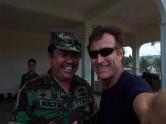
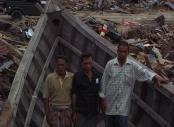



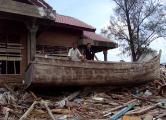
A boat still intact
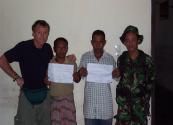
Sea Commander, Boat
Builder, Local Military
Authority
Builder, Local Military
Authority
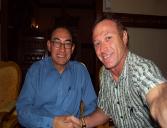
Minister Alwi Shahib